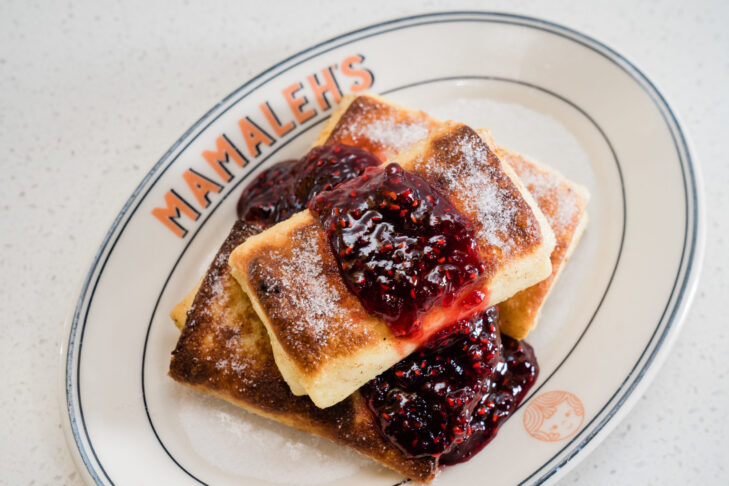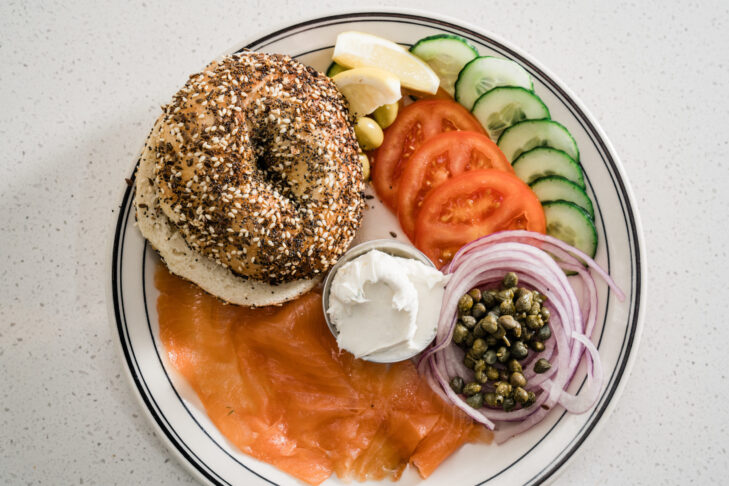Rachel Sundet, a chef/baker known for the success of Mamaleh’s Delicatessen & Restaurant, oversees the busy bakery department, making bagels, bialys, challah, babka and much more. She was named a StarChefs Rising Star Pastry Chef and Boston Magazine‘s Best Pastry Chef in 2015. She spoke to JewishBoston about all things carbs and dairy in anticipation of her Jewish Arts Collaborative JLive appearance on June 3.
Bread is traditionally considered life-sustaining. What part does bread play in Mamaleh’s culinary lineup?
Bread is a foundational part of everything. At Mamaleh’s, it anchors us in many ways. We make bagels every day, and we also make challah every day. We use our own challah rolls for a lot of our sandwiches. Bread is also a cornerstone of baking. Making bread is also about going beyond a recipe. With yeasted things, you have to use your senses and pay attention to what’s happening in your dough to get the best product from it. These recipes require you to go beyond reading the directions, follow along and be a participant.
What bread-based food are your favorites to make?
I love making bagels! I’m not in the kitchen regularly now. But when I was working the opening shifts, I always loved the boil shift where you’re responsible for baking all the bagels for the day. It’s challenging because you have to get up early and be ready to move quickly before you’re awake. But once you get into that zone, it’s satisfying. And that first opening of the oven, where you get this whiff of spice and yeast, it’s just pure satisfaction. It’s one of the best feelings to fill up your whole rack with freshly baked bagels and see that project to completion. It takes three days, and many people have had their hands in the entire bagel-making process.
Bagel-making sounds very involved. Can you take us through the steps?

We make our pre-ferment on day one. And that’s a mini version of what goes into the bagels. It’s flour and a little bit of salt and a little bit of yeast and water. You mix it and then leave it to ferment at room temperature for about an hour. It then goes into the fridge overnight so that when we mix the bagels the next day, the pre-ferment goes into the final dough. You add more water, flour, salt, a little bit of sugar and a little bit of diastatic malt powder, which is an enzyme that helps with the chewiness of the crust and gives a little bit of sweetness. That pre-ferment changes the texture from a bread product that’s just baked in a round shape to that chewy, slightly denser, kind of moist bread on the inside and heartier texture on the outside. That all happens on day two. We then shape that dough into a bagel and put it in the fridge overnight. A baker comes in first thing in the morning on day three and boils and bakes all of them. So, it is quite a process. We make 700-800 bagels every day!
Shavuot is around the corner. Tell us about Mamaleh’s blintzes, kugel and the cheesecake that is to die for!
We have a New York-style cheesecake that is cream-cheese-rich, dense and velvety creamy. It’s very smooth and delicious. It’s a classic cheesecake, and we top it with rotating fruit preserves or a compote. It has a gluten-free crust that tastes like honey-oat mixture. It tastes a bit like the Nature Valley oat and honey granola bars!
Our cheesecake is a blank canvas for flavor, so that’s why we like to top it with a rotating fruit option. Fresh fruit is a great topping too. But our cheesecake is good by itself also. So, we have that on the menu, and then we also make kugel. The version we currently make is for our retail freezers. It comes in a gold foil pan that serves two to three people. It’s a classic noodle kugel recipe. It has farmers cheese, sour cream, eggs, butter and egg noodles. It’s comfort food. We also top ours with some cinnamon, sugar and cornflakes. One of my business partners grew up with cornflakes on top of kugel. I was skeptical, but we tried it and it was delicious! It’s a nice textural change to the softness of the noodles and the custard that goes in it.
The blintzes are a total labor of love. We make the crepes from scratch with flour and a few eggs and not much else. There’s also a little bit of sugar and salt. You cook these thin, beautiful pancakes and fill them with a mixture of farmers cheese, eggs, a little bit of sugar, sour cream and some butter. Then you fold them up like little burritos and delicately assemble them. Pre-COVID, we served them in the restaurant, hot with raspberry jam. Post-COVID, we’ve turned the blintzes into a retail freezer product also. We bag up four blintzes with instructions for people to cook them at home.
Are gluten-free products challenging to make?
It depends. We have gluten-free items, and when we develop them, we try to make them naturally gluten-free. For example, we’re not necessarily trying to make challah that is gluten-free, but instead, it’s maybe a dessert that we’re doing that happens to be gluten-free. That’s my favorite way of doing things. Our cheesecake, for example, is gluten-free with that delicious oat crust that happens to have no flour in it. We’ve tried to embrace gluten-free baking and use it as a learning experience. We also offer vegan products. We’re learning how to replace different products to meet those dietary needs. It’s a point of education for us as we see how things work or don’t work. There are certainly limitations, but there’s also a lot of possibilities.
Hear more from Rachel Sundet on Friday, June 3, at noon, where she will be in (virtual) conversation with Laura Mandel, executive director of Jewish Arts Collaborative.












